Properties of Non-Structural Concrete Made with Mixed Recycled Aggregates and Low Cement Content
Abstract
:1. Introduction
2. Literary Review
3. Materials and Experimental Details
3.1. Materials
3.1.1. Mixed Recycled Aggregates
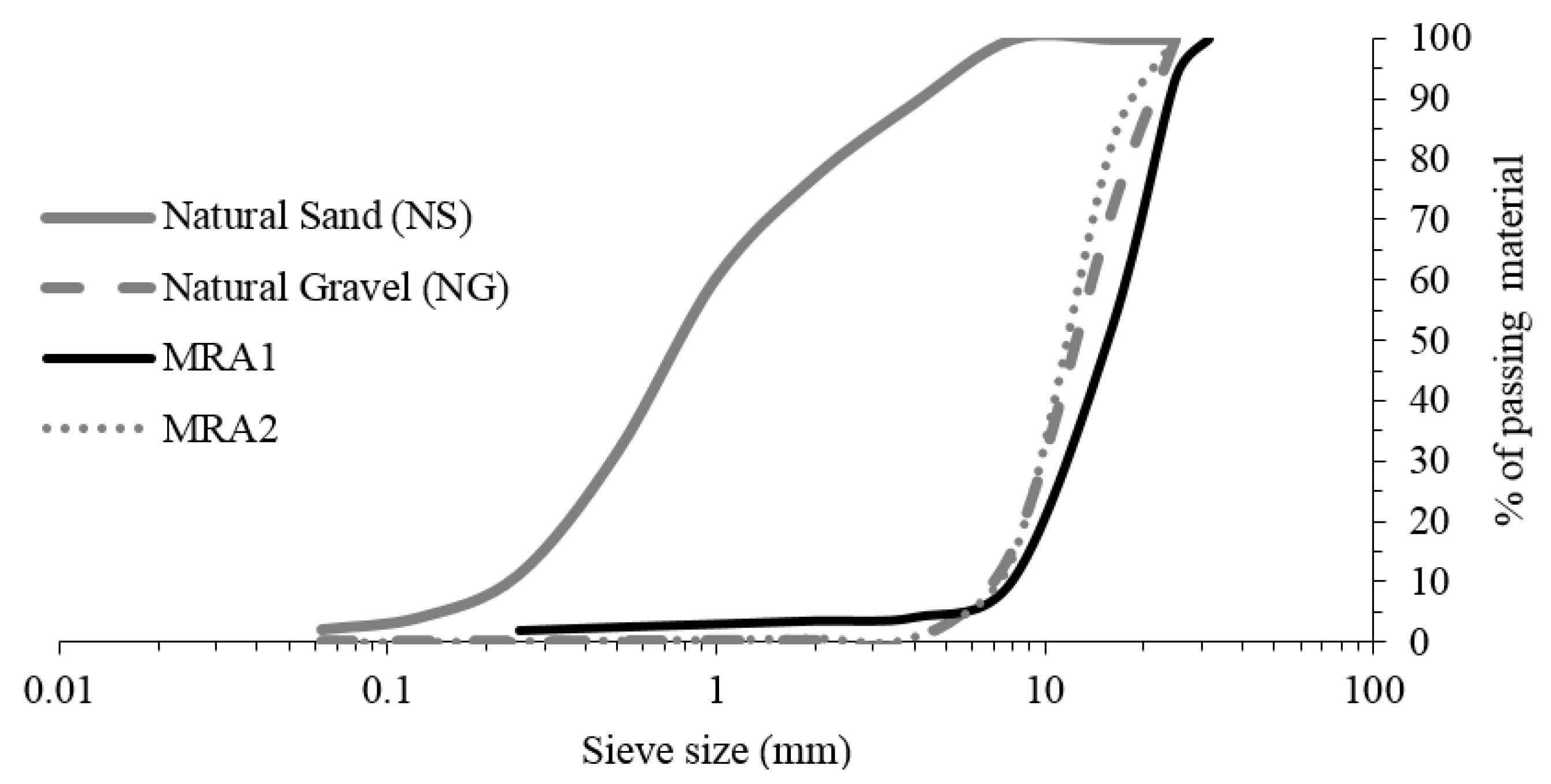
| Physical Properties | According to Standard | MRA1 | MRA2 | EHE-08 Requirements |
| Water absorption (%) | UNE-EN 1097-6:2014 [31] | 6.1 | 9.0 | <5% General, <7% RCA |
| Oven-dried density (Mg/m3) | UNE-EN 1097-6:2014 [31] | 2.24 | 2.08 | - |
| SSD density (Mg/m3) | UNE-EN 1097-6:2014 [31] | 2.38 | 2.27 | - |
| Flakiness index (%) | UNE-EN 933-3:2012 [32] | 10.8 | 14.7 | <35 |
| Los Angeles Abrasion test | UNE-EN 1097-2:2010 [33] | 35.6 | 32.3 | <40 |
| Freeze-thaw resistance (%) | UNE-EN 1367-2:2010 [34] | 5.2 | 14.0 | <18% |
| Chemical properties | According to Standard | MRA1 | MRA2 | EHE-08 Requirements |
| Total sulfur content (% S) | UNE-EN 1744-1-11:2010 [35] | 1.02 | 0.96 | <1 |
| Acid-soluble sulfates (% SO3) | UNE-EN 1744-1-12:2010 [36] | 0.65 | 0.62 | <0.8 |
| Chlorides (%) | UNE-EN 1744-1-7:2010 [37] | <0.01 | <0.01 | <0.05 |
| Components (%) | UNE-EN 933-11:2009 [38] | - | - | - |
| Asphalt | - | 0.9 | 0.5 | - |
| Ceramics | - | 13.9 | 30.2 | - |
| Mortar and concrete | - | 49.0 | 44.6 | - |
| Unbound aggregates | - | 34.9 | 24.0 | - |
| Gypsum | - | 0.4 | 0.5 | - |
| Others (wood, glass, plastic, and metal) | - | 0.9 | 0.2 | - |
3.1.2. Natural Aggregates
| Physical Properties | According to Standard | NS | NG |
| Water absorption (%) | UNE-EN 1097-6:2014 [31] | 0.92 | 0.73 |
| SSD density (Mg/m3) | UNE-EN 1097-6:2014 [31] | 2.66 | 2.70 |
| Flakiness index (%) | UNE-EN 933-3:2012 [30] | - | 20.60 |
| Los Angeles abrasion test | UNE-EN 1097-2:2010 [33] | - | 18.10 |
| Friability test | UNE 83115:1989 [39] | 12.40 | - |
| Chemical properties | According to Standard | NS | NG |
| Total sulfur content (% S) | UNE-EN 1744-1-11:2010 [35] | 0.36 | 0.57 |
| Acid-soluble sulfates (% SO3) | UNE-EN 1744-1-12:2010 [36] | 0.17 | 0.51 |
| Chlorides (%) | UNE-EN 1744-1-7:2010 [37] | <0.01 | <0.01 |
3.1.3. Cement
| Loss on Ignition (%) | Specific Mass (Mg/m3) | Blaine Specific Surface Area (m2/kg) | SiO2 | Al2O3 | Fe2O3 | MgO | CaO | Na2O | K2O |
|---|---|---|---|---|---|---|---|---|---|
| (%) | |||||||||
| 1.38 | 2.89 | 351.9 | 26.49 | 8.70 | 3.31 | 1.41 | 54.36 | 3.26 | 1.43 |
3.1.4. Admixtures
3.2. Experimental Details.
3.2.1. Mix Proportions
- Amount of cement. Two cement contents were used: 180 and 200 kg/m3.
- Replacement ratio of coarse aggregate. Four levels were used: 0%, 20%, 40%, and 100%. The replacement percentage was calculated using the equivalent volume.
- Type of MRA. Two MRA (MRA1 and MRA2) were tested, with different percentages of ceramic particles.
| Samples | Replacement Ratio (%) | Proportions (kg/m3) | ||||||
|---|---|---|---|---|---|---|---|---|
| Cement | Water | NS | NG | MRA | Plasticizer | Superplasticizer | ||
| CC-I | 0 | 180 | 117 | 1100 | 950 | 0 | 1.92 | 2.15 |
| CMRA1-20-I | 20 | 180 | 117 | 1100 | 759 | 147 | 1.92 | 2.15 |
| CMRA1-40-I | 40 | 180 | 117 | 1100 | 569 | 294 | 1.92 | 2.15 |
| CMRA1-100-I | 100 | 180 | 117 | 1100 | 0 | 735 | 1.92 | 2.15 |
| CMRA2-20-I | 20 | 180 | 117 | 1100 | 817 | 144 | 1.92 | 2.15 |
| CMRA2-40-I | 40 | 180 | 117 | 1100 | 613 | 288 | 1.92 | 2.15 |
| CMRA2-100-I | 100 | 180 | 117 | 1100 | 0 | 720 | 1.92 | 2.15 |
| Samples | Replacement Ratio (%) | Proportions (kg/m3) | ||||||
|---|---|---|---|---|---|---|---|---|
| Cement | Water | NS | NG | MRA | Plasticizer | Superplasticizer | ||
| CC-II | 0 | 200 | 130 | 1070 | 950 | 0 | 2.13 | 2.39 |
| CMRA1-20-II | 20 | 200 | 130 | 1070 | 759 | 147 | 2.13 | 2.39 |
| CMRA1-40-II | 40 | 200 | 130 | 1070 | 569 | 294 | 2.13 | 2.39 |
| CMRA1-100-II | 100 | 200 | 130 | 1070 | 0 | 735 | 2.13 | 2.39 |
| CMRA2-20-II | 20 | 200 | 130 | 1070 | 817 | 144 | 2.13 | 2.39 |
| CMRA2-40-II | 40 | 200 | 130 | 1070 | 613 | 288 | 2.13 | 2.39 |
| CMRA2-100-II | 100 | 200 | 130 | 1070 | 0 | 720 | 2.13 | 2.39 |
3.2.2. Mixing Process

3.2.3. Test Method
| Test | Standards | Form and Sample Dimensions |
|---|---|---|
| Slump test for workability | UNE-EN 12350-2:2009 [43] | Cubic: 100 × 100 × 100 mm |
| Compressive strength | UNE-EN 12390-3:2009 [44] | Cylindrical: Ø 150 × 300 mm |
| Tensile splitting strength | UNE-EN 12390-6:2009 [45] | Cylindrical: Ø 100 × 200 mm |
| Static modulus of elasticity in compression | UNE 83316:1996 [46] | Cylindrical: Ø 150 × 300 mm |
| Density of hardened concrete | UNE-EN 12390-7:2009 [47] | Cubic: 150 × 150 × 150 mm |
| Porosity of hardened concrete | UNE-EN 12390-7:2009 [47] | Cubic: 150 × 150 × 150 mm |
| Penetration of water under pressure | UNE-EN 12390-8:2009 [48] | Cylindrical: Ø 150 × 300 mm |
| Determination of sorptivity | UNE- EN 1925:1999 [49] | Cubic: 100 × 100 × 100 mm |
4. Results and Discussion
| Samples | fccub, MPa | c.v. | fccyl, MPa | c.v. | Splitting Tensile Strength, MPa | c.v. | Modulus of Elasticity, GPa | c.v. | SSD-Density, Mg·m−3 | c.v. | Porosity, % | c.v. | Water Penetration, mm | c.v. | Sorptivity, mm·h−1/2 | c.v. |
|---|---|---|---|---|---|---|---|---|---|---|---|---|---|---|---|---|
| CC-I | 29.0 | 1.37 | 20.8 | 2.53 | 2.42 | 2.74 | 15.3 | 3.94 | 2.31 | 0.74 | 11.7 | 1.41 | 57.0 | 6.24 | 0.57 | 7.17 |
| CMRA1-20-I | 23.8 | 1.01 | 19.6 | 1.68 | 2.36 | 3.78 | 14.5 | 2.35 | 2.29 | 0.50 | 11.8 | 2.16 | 89.0 | 3.31 | 0.59 | 6.92 |
| CMRA1-40-I | 20.5 | 4.26 | 18.6 | 0.90 | 2.02 | 3.52 | 12.5 | 5.94 | 2.25 | 0.44 | 13.3 | 1.62 | 96.0 | 3.90 | 0.76 | 6.45 |
| CMRA1-100-I | 18.5 | 1.14 | 17.3 | 4.86 | 1.58 | 15.68 | 10.5 | 9.06 | 2.24 | 0.10 | 14.1 | 0.72 | 97.5 | 7.26 | 0.94 | 4.84 |
| CMRA2-20-I | 21.7 | 1.95 | 20.0 | 1.45 | 2.35 | 6.02 | 14.4 | 2.96 | 2.26 | 0.19 | 12.2 | 1.39 | 63.0 | 9.07 | 0.62 | 12.58 |
| CMRA2-40-I | 21.1 | 0.56 | 19.2 | 0.21 | 2.10 | 2.26 | 12.8 | 3.58 | 2.24 | 0.42 | 13.1 | 1.27 | 74.7 | 7.91 | 0.81 | 9.07 |
| CMRA2-100-I | 20.5 | 0.82 | 19.0 | 0.77 | 1.97 | 10.58 | 11. 9 | 1.56 | 2.20 | 0.47 | 13.9 | 0.37 | 76.5 | 3.74 | 0.99 | 7.05 |
| CC-II | 34.6 | 2.74 | 25.8 | 0.54 | 2.81 | 1.28 | 17.6 | 3.87 | 2.38 | 0.51 | 10.9 | 1.35 | 34.0 | 8.66 | 0.25 | 14.93 |
| CMRA1-20-II | 32.7 | 1.20 | 24.8 | 1.43 | 2.60 | 3.02 | 15.8 | 2.84 | 2.36 | 0.23 | 11.3 | 1.10 | 45.3 | 9.24 | 0.36 | 9.46 |
| CMRA1-40-II | 30.1 | 0.42 | 23.6 | 0.97 | 2.29 | 3.97 | 15.5 | 2.86 | 2.33 | 0.31 | 13.2 | 0.88 | 52.7 | 5.44 | 0.55 | 3.93 |
| CMRA1-100-II | 22.8 | 4.26 | 20.5 | 0.90 | 2.18 | 3.52 | 11.6 | 8.60 | 2.25 | 0.54 | 13.9 | 1.43 | 78.0 | 6.28 | 0.89 | 6.66 |
| CMRA2-20-II | 34.5 | 0.63 | 25.0 | 1.77 | 2.63 | 2.19 | 16.7 | 2.29 | 2.30 | 0.62 | 11.5 | 1.97 | 36.3 | 7.16 | 0.56 | 5.15 |
| CMRA2-40-II | 33.8 | 3.66 | 24.5 | 1.29 | 2.35 | 2.83 | 16.2 | 2.47 | 2.29 | 0.16 | 13.1 | 0.94 | 45.3 | 7.28 | 0.73 | 5.59 |
| CMRA2-100-II | 27.6 | 3.94 | 23.4 | 1.20 | 2.21 | 7.23 | 13.1 | 4.83 | 2.25 | 0.50 | 13.5 | 0.10 | 76.5 | 6.94 | 1.03 | 3.76 |
| Properties | Factors | ||||||||
|---|---|---|---|---|---|---|---|---|---|
| Amount of Cement (kg/m3) | (%) of Replacement | Type or MRA | |||||||
| - | Factor levels | 180 | 200 | 0 | 20 | 40 | 100 | 1 | 2 |
| Degrees of freedom | (1;12) | (3;10) | (1;10) | ||||||
| Compressive strength (fccyl) | p-value | <0.0001 | <0.0001 | 0.5477 | |||||
| c.v. | 5.3 | 6.7 | 7.4 | 3.6 | 2.1 | 9.9 | 8.1 | 2.9 | |
| Tensile splitting strength | p-value | 0.0439 | <0.0001 | 0.6006 | |||||
| c.v. | 13.0 | 9.2 | 13 | 8.5 | 4.5 | 16.4 | 12.9 | 7.5 | |
| Modulus of elasticity in compression | p-value | 0.0647 | <0.0001 | 0.5225 | |||||
| c.v. | 11.9 | 12.9 | 13.9 | 8.0 | 4.4 | 21.6 | 14.5 | 9.5 | |
| Density of hardened concrete | p-value | 0.0443 | <0.0001 | 0.2568 | |||||
| c.v. | 1.5 | 2.0 | 2.7 | 1.4 | 0.7 | 2.3 | 1.6 | 1.5 | |
| Porosity of hardened concrete | p-value | 0.5132 | <0.0001 | 0.9602 | |||||
| c.v. | 7.1 | 9.0 | 12.3 | 8.5 | 4.0 | 8.5 | 8.2 | 6.3 | |
| Penetration of water under pressure | p-value | 0.0023 | 0.0016 | 0.1081 | |||||
| c.v. | 18.5 | 31.6 | 44.9 | 22.3 | 14.1 | 24.1 | 20.1 | 22.6 | |
| Sorptivity | p-value | 0.3218 | <0.0001 | 0.3875 | |||||
| c.v. | 20.8 | 41.3 | 72.0 | 32.4 | 9.9 | 29.6 | 27.3 | 26.2 | |
4.1. Effect of Cement Content
4.1.1. Mechanical Properties
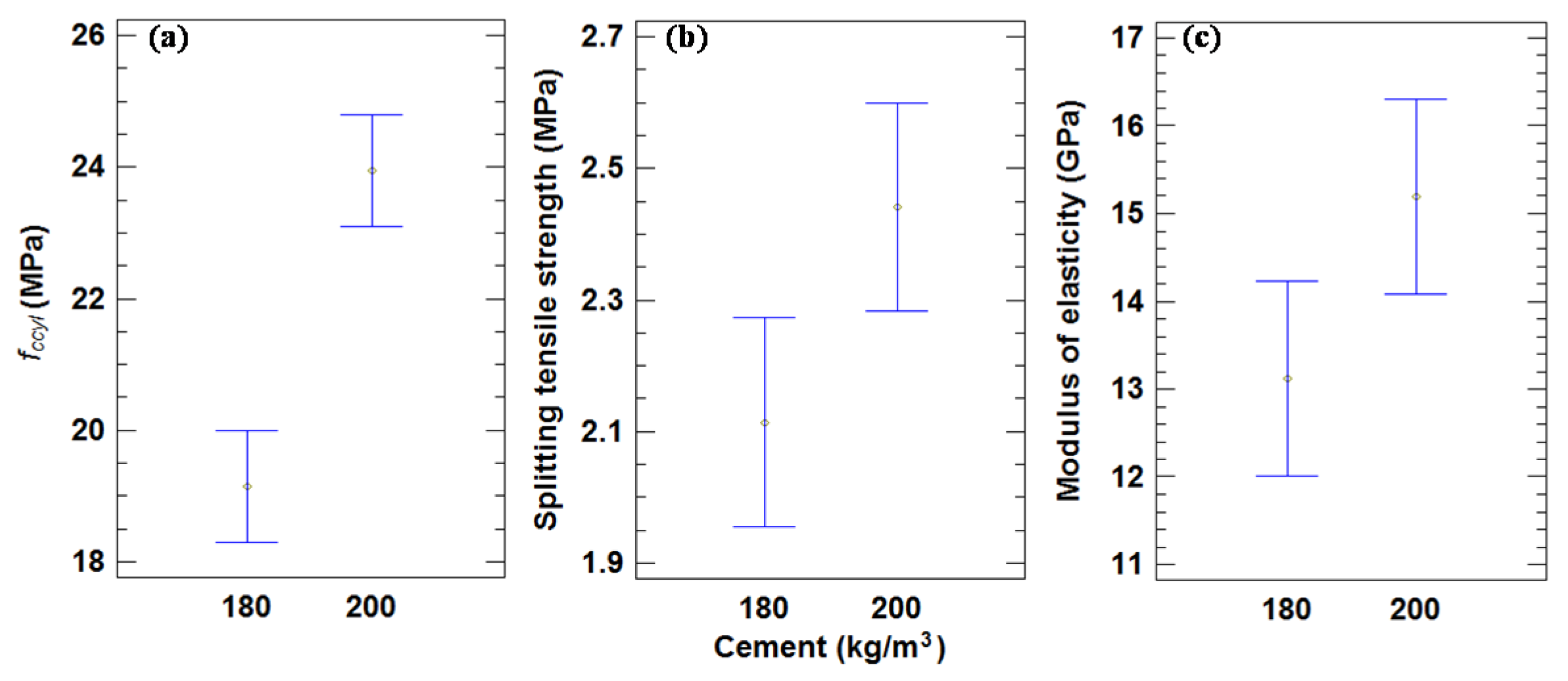
| Cement content | 180 kg of Cement/m3 | ||||||
| Samples | CC | CMRA1-20 | CMRA1-40 | CMRA1-100 | CMRA2-20 | CMRA2-40 | CMRA2-100 |
| fcm | 21 | 20 | 19 | 17 | 20 | 19 | 19 |
| fck | 14 | 13 | 12 | 10 | 13 | 12 | 12 |
| Cement content | 200 kg of Cement/m3 | ||||||
| Samples | CC | CMRA1-20 | CMRA1-40 | CMRA1-100 | CMRA2-20 | CMRA2-40 | CMRA2-100 |
| fcm | 26 | 25 | 24 | 21 | 25 | 25 | 23 |
| fck | 19 | 18 | 17 | 14 | 18 | 18 | 16 |
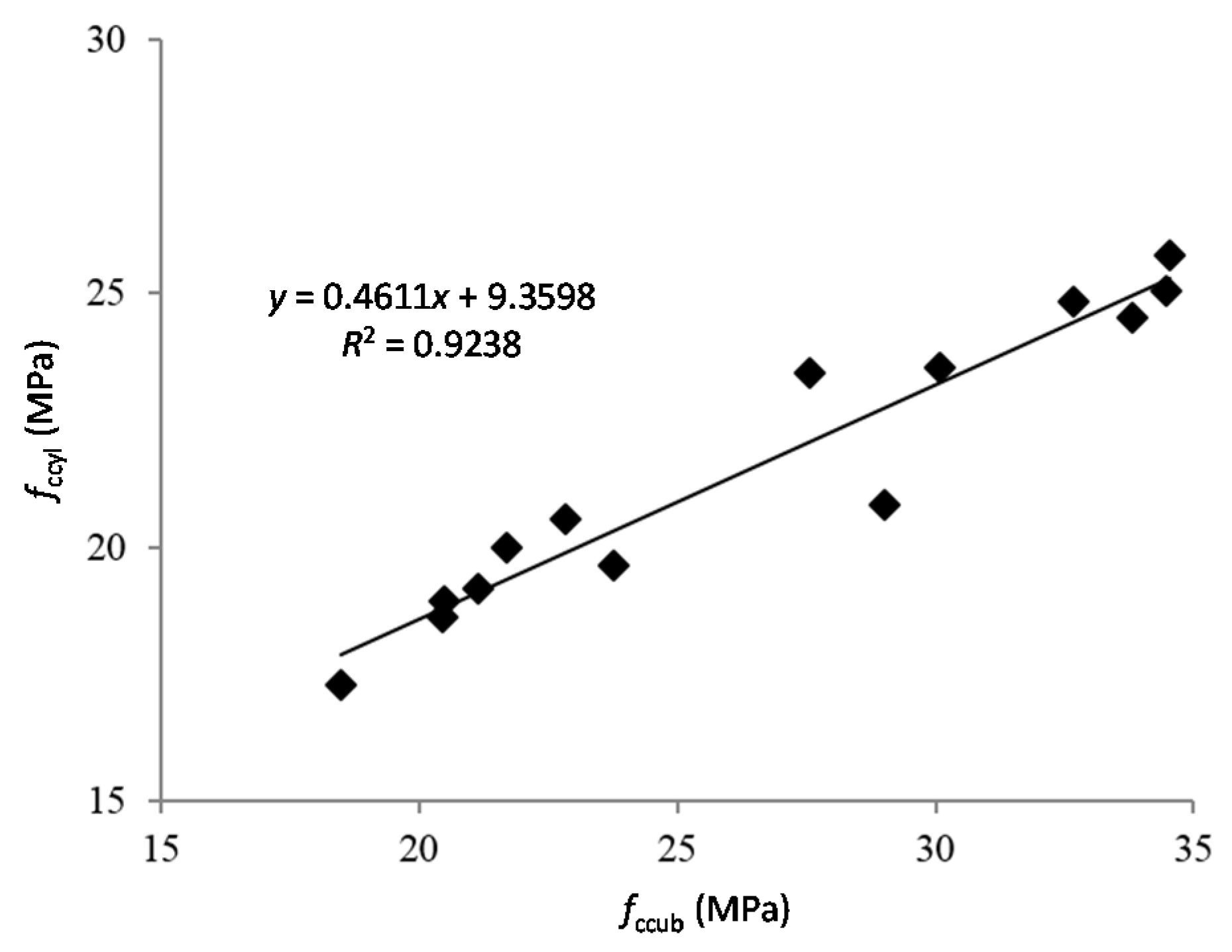
4.1.2. Physical Properties

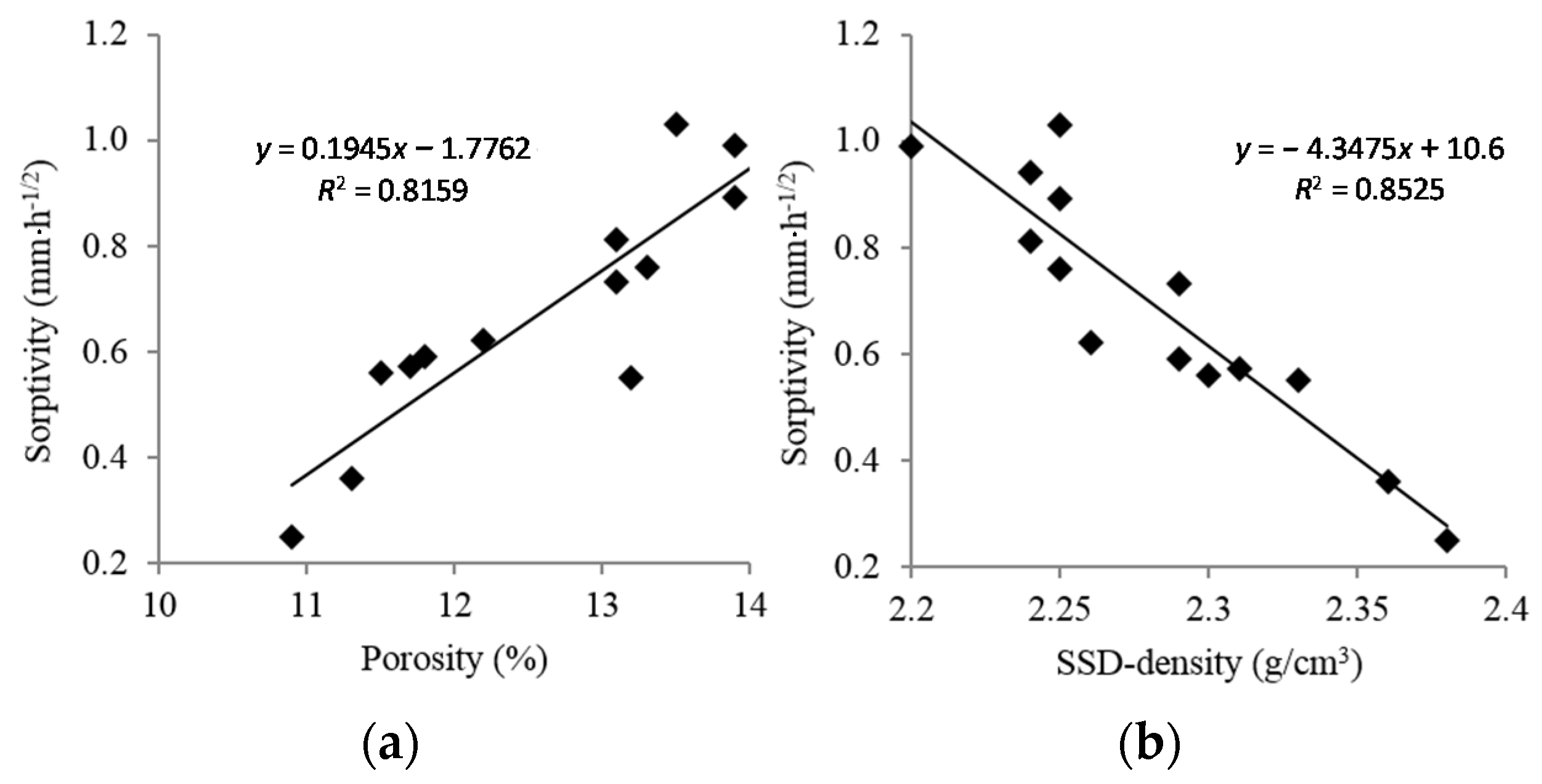
4.2. Effect of Replacement Ratio
4.2.1. Mechanical Properties
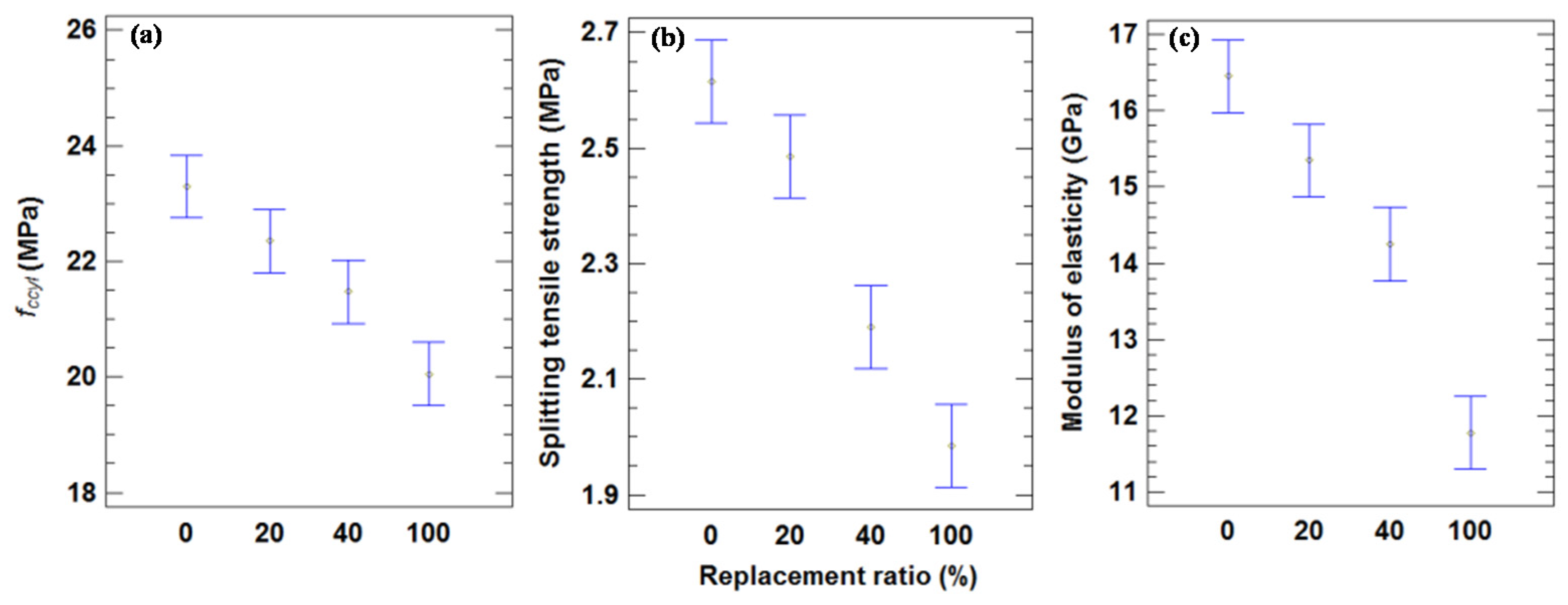
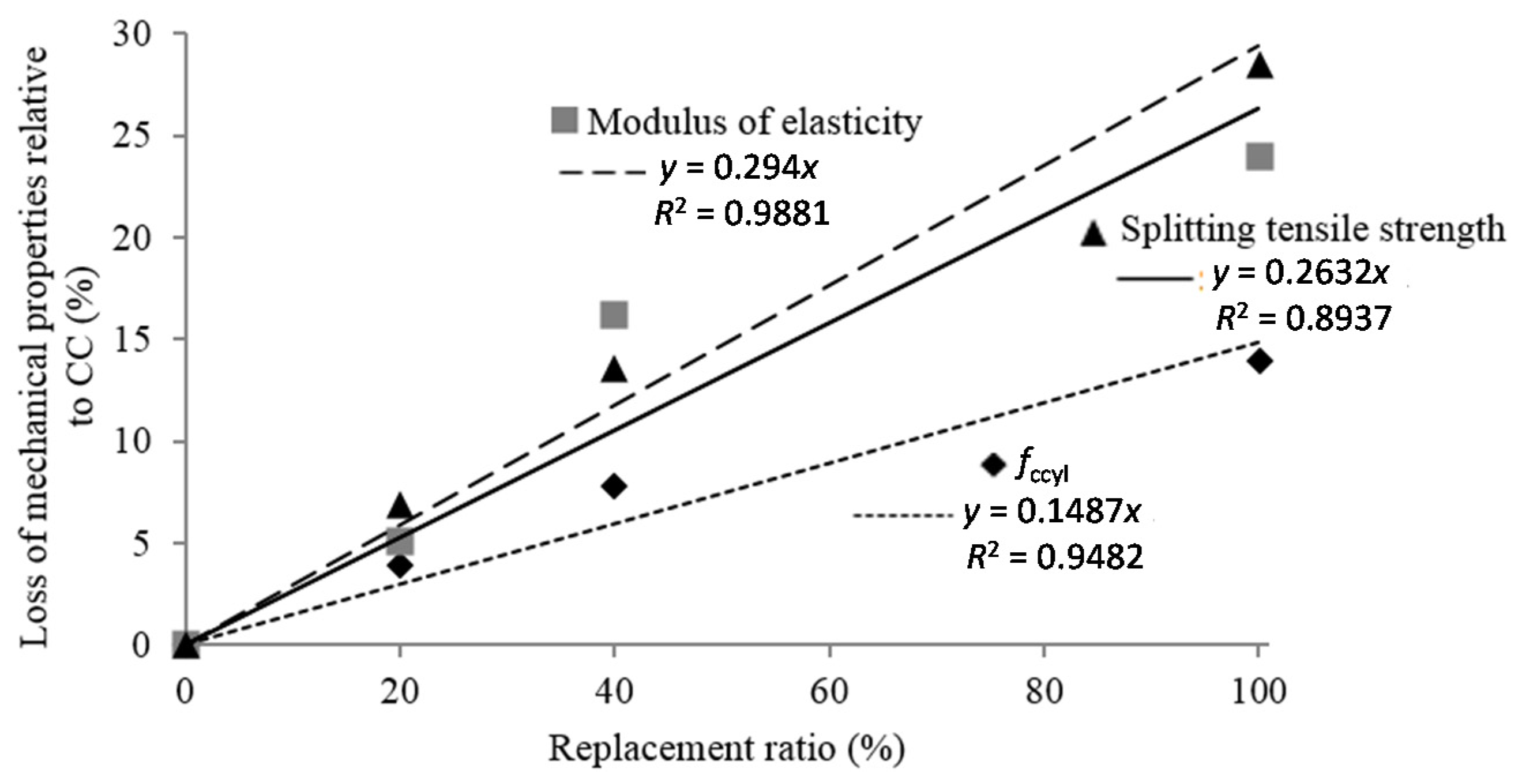
4.2.2. Physical Properties

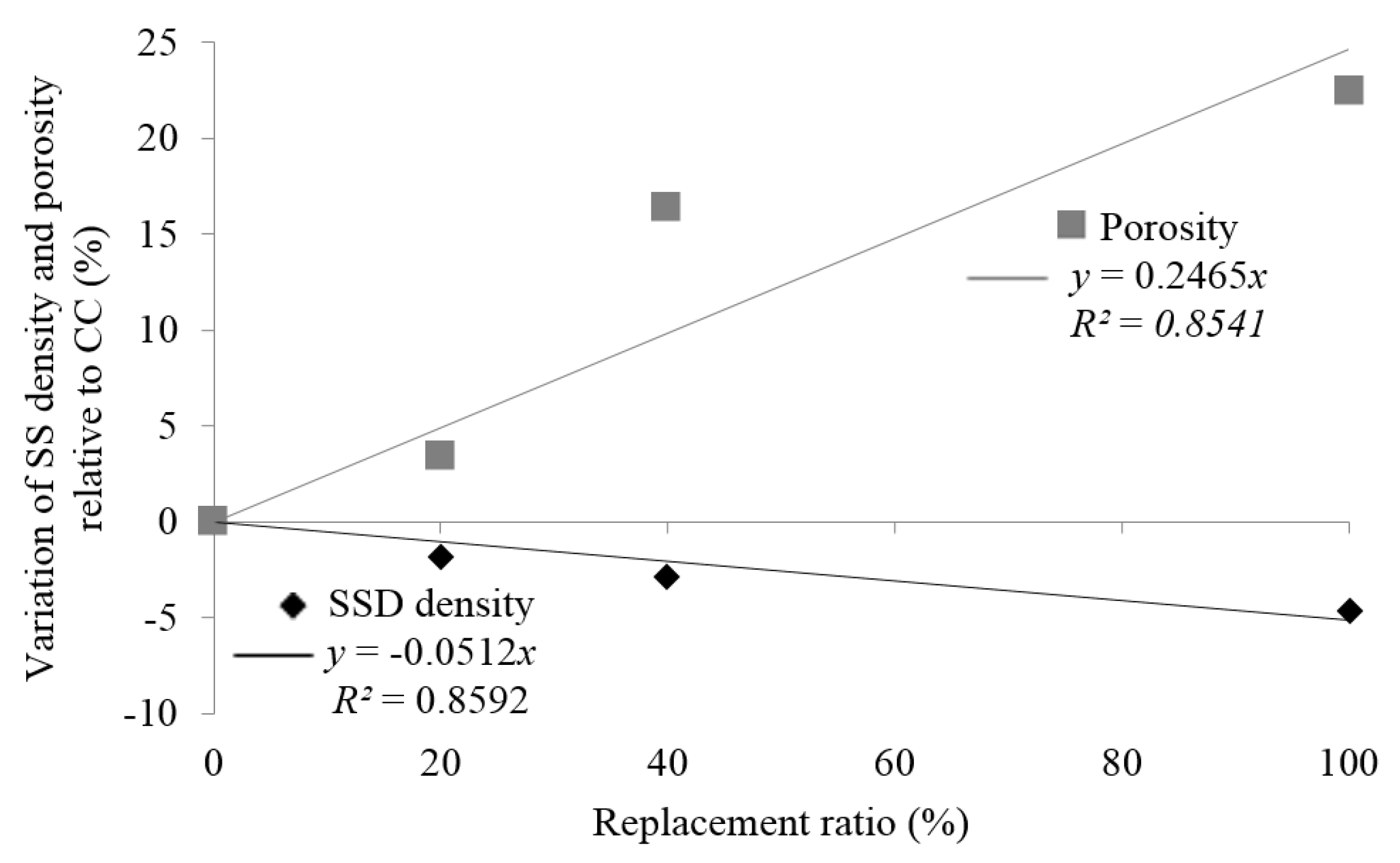

4.3. Effect of Type of Aggregate
4.3.1. Mechanical Properties
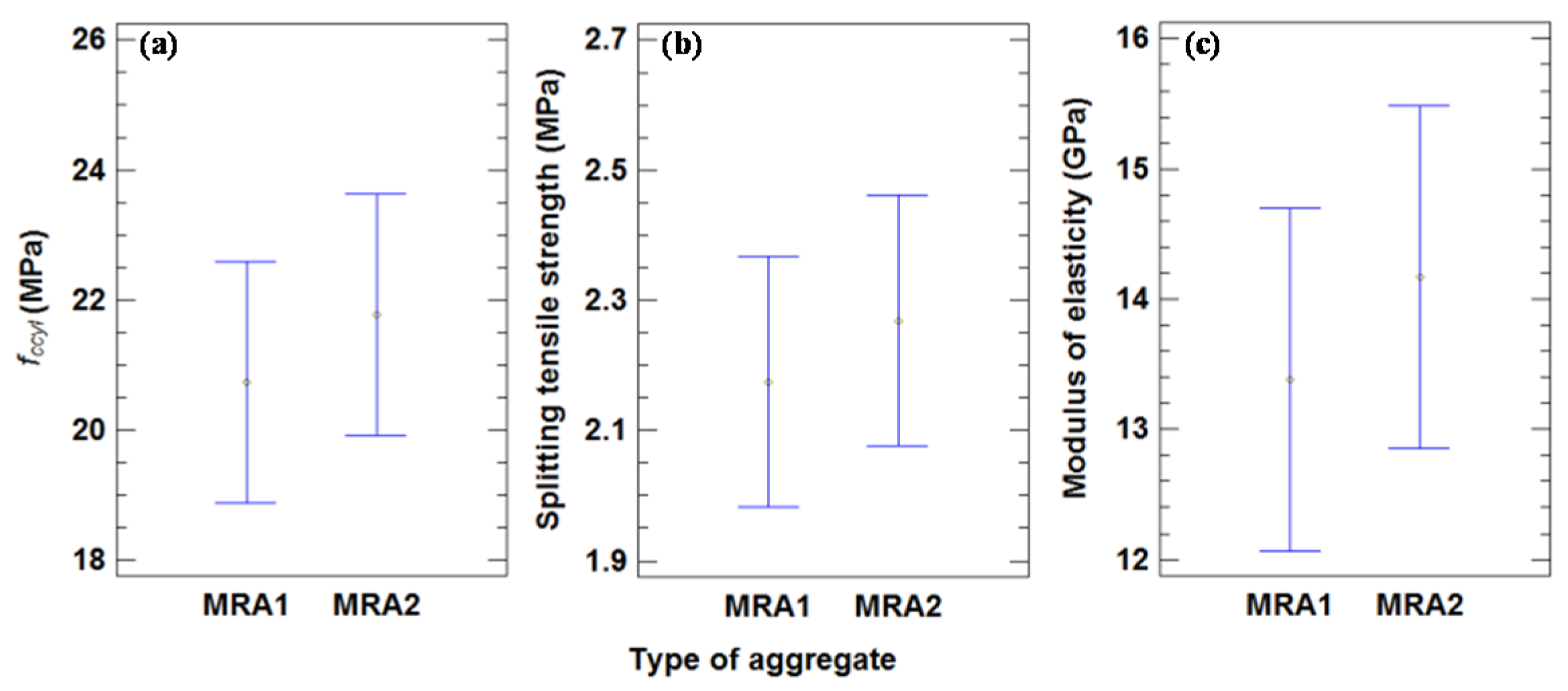
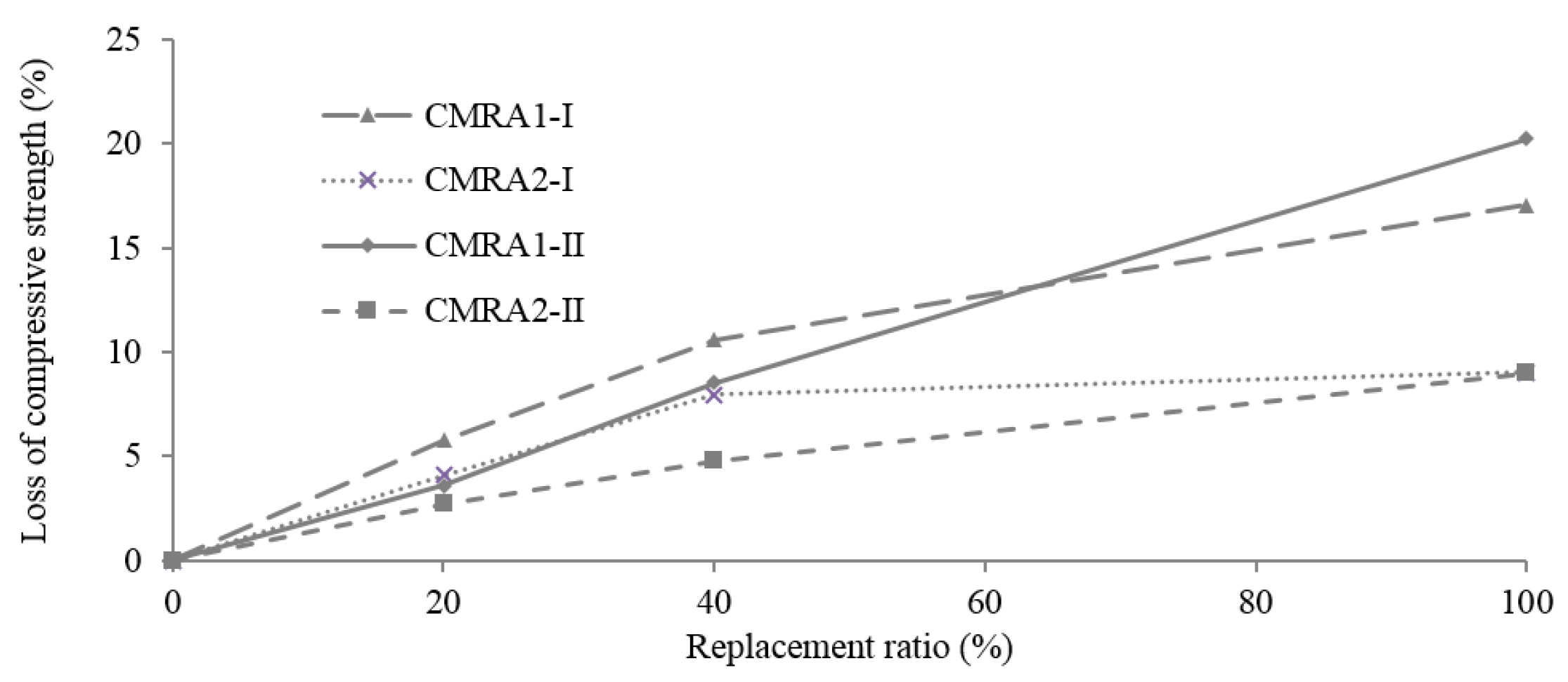
4.3.2. Physical Properties

5. Conclusions
- The main factors that affect the properties analyzed in this research are the amount of cement and the replacement ratio.
- The type of aggregate used in this research had no statistically significant effects on the properties analyzed.
- Excellent linear correlations between the percentage of substitution and loss of compressive strength, tensile strength, and the modulus of elasticity were found. These losses decrease with the amount of cement.
- Excellent linear correlations between the replacement ratio and increases in porosity, depth of water penetration under pressure and sorptivity were found. These are properties that adversely affect the durability, but the correlations do not present a negative impact for the purpose of this study, as a concrete without steel reinforcement is being sought.
- A replacement ratio of up to 20% of coarse natural aggregates by MRA presents no statistically significant differences in strength properties compared with the control concrete.
- It is possible to achieve a non-structural, low-strength concrete (15 MPa) with an MRA replacement ratio of up to 100% with 200 kg/m3 of cement. Previous studies have used cement quantities exceeding 240 kg/m3 for manufacturing non-structural concretes with MRA.
- Even though non-structural concrete made with MRA is not allowed by Spanish Code EHE-08, the results obtained here support its viability. Experimentation on a larger scale is required to confirm these results. This concrete could be used in the construction of ditches, sidewalks, and similar works, with the environmental benefits indicated above.
Acknowledgments
Author Contributions
Conflicts of Interest
References
- Higuchi, T.; Moriokaa, M.; Yoshioka, I.; Yokozeki, K. Development of a new ecological concrete with CO2 emissions below zero. Constr. Build. Mater. 2014, 67, 338–343. [Google Scholar] [CrossRef]
- De Schepper, M.; van den Heede, P.; van Driessche, I.; de Belie, N. Life cycle assessment of completely recyclable concrete. Materials 2014, 7, 6010–6027. [Google Scholar] [CrossRef] [Green Version]
- Damtoft, J.S.; Lukasik, J.; Herfort, D.; Sorrentino, D.; Gartner, E.M. Sustainable development and climate change initiatives. Cem. Concr. Res. 2008, 38, 115–127. [Google Scholar] [CrossRef]
- European Commision (DG ENV). Final Report Task 2: Service Contract on Management of Construction and Demolition Waste Prepared by Bio Intelligent Service. 2011. Available online: http://ec.europa.eu/environment/waste/pdf/2011_CDW_Report.pdf (accessed on 3 April 2015).
- European Environment Agency. EU as a Recycling Society—Present Recycling Levels of Municipal Waste and Construction & Demolition Waste in the EU. 2009. Available online: http://scp.eionet.europa.eu/publications/wp2009_2/wp/WP2009_2 (accessed on 7 April 2015).
- Van der Sloot, H.A. Readily accessible data and integrated approach is needed for evaluating waste treatment options and preparation of materials for beneficial use. Waste Manag. 2009, 24, 751–752. [Google Scholar] [CrossRef] [PubMed]
- Eikelboom, R. Challenges environmental evaluation and use of recycling materials. In Proceedings of the 6th International Conference Environmental and Technical Implications of Construction with Alternative Materials, Belgrade, Serbia, 30 May–2 June 2006.
- Knoeri, C.; Sanye-Mengual, E.; Althau, H.J. Comparative LCA of recycled and conventional concrete for structural applications. Int. J. Life Cycle Assess. 2013, 18, 909–918. [Google Scholar] [CrossRef]
- Boletín Oficial del Estado (BOE). Plan Nacional Integrado de Residuos para el período 2008-2015. 2009. Available online: https://www.boe.es/boe/dias/2009/02/26/pdfs/BOE-A-2009-3243.pdf (accesed on 7 April 2015). (In Spanish)
- CEDEX. Catálogo de Residuos. Residuos de Construcción y Demolición 2010. Available online: http://www.cedexmateriales.vsf.es/view/catalogo.aspx (accessed on 7 April 2015). (In Spanish)
- Spanish Ministry of Public Works. Code on Structural Concrete, EHE-08, Permanent Commission of the Concrete; Spanish Ministry of Public Works: Madrid, Spain, 2008. [Google Scholar]
- Gonçalves, P.; de Brito, J. Recycled aggregate concrete (RAC) comparative analysis of existing specifications. Mag. Concr. Res. 2010, 62, 339–346. [Google Scholar] [CrossRef]
- Thomas, C.; Setién, J.; Polanco, J.A.; Alaejos, P.; Sanchez de Juan, M. Durability of recycled aggregate concrete. Constr. Build. Mater. 2013, 40, 1054–1065. [Google Scholar] [CrossRef]
- Rahal, K. Mechanical properties of concrete with recycled coarse aggregate. Build. Environ. 2007, 42, 407–415. [Google Scholar] [CrossRef]
- Exteberria, M.; Vázquez, E.; Marí, A.; Barra, M. Influence of amount of recycled coarse aggregates and production process on properties of recycled aggregate concrete. Cem. Concr. Res. 2007, 37, 735–742. [Google Scholar]
- Malešev, M.; Radonjanin, V.; Marinković, S. Recycled concrete as aggregate for structural concrete production. Sustainability 2010, 2, 1204–1225. [Google Scholar] [CrossRef]
- Brito, J.; Pereira, A.S.; Correia, J.R. Mechanical behaviour of non-structural concrete made with recycled ceramic aggregates. Cem. Concr. Compos. 2005, 27, 429–433. [Google Scholar] [CrossRef]
- Cachim, P.B. Mechanical properties of brick aggregate concrete. Constr. Build. Mater. 2009, 23, 1292–1297. [Google Scholar] [CrossRef]
- Yang, J.; Du, Q.; Bao, Y. Concrete with recycled concrete aggregate and crushed clay bricks. Constr. Build. Mater. 2011, 25, 1935–1945. [Google Scholar] [CrossRef]
- Guerra, I.; Vivar, I.; Llamas, B.; Juan, A.; Moran, J. Eco-efficient concretes: The effects of using recycled ceramic material from sanitary installations on the mechanical properties of concrete. Constr. Build. Mater. 2009, 29, 643–646. [Google Scholar] [CrossRef] [PubMed]
- Ihobe. Usos de áridos reciclados mixtos procedentes de Residuos de Construcción y Demolición. Available online: http://www.caminospaisvasco.com/Profesion/documentostecnicos/usosaridos (accessed on 7 April 2015). (In Spanish)
- Sanchez, R. Análisis de la Aplicabilidad de los Áridos Reciclados Mixtos en Hormigones. Tesina de Especialidad, Universidad Politécnica de Cataluña, Barcelona, España, 2011. [Google Scholar]
- Mas, B.; Cladera, A.; del Olmo, T.; Pitarch, F. Influence of the amount of mixed recycled aggregates on the properties of concrete for non-structural use. Constr. Build. Mater. 2012, 27, 612–622. [Google Scholar] [CrossRef]
- Medina, C.; Zhu, W.; Howind, T.; Sánchez de Rojas, M.I.; Frías, M. Influence of mixed recycled aggregate on the physical-mechanical properties of recycled concrete. J. Clean. Prod. 2014, 68, 216–225. [Google Scholar] [CrossRef]
- Mas, B.; Cladera, A.; Bestard, J.; Muntaner, D.; López, C.E.; Piña, S.; Prades, J. Concrete with mixed recycled aggregates: Influence of the type of cement. Constr. Build. Mater. 2012, 34, 430–441. [Google Scholar] [CrossRef]
- Martínez-Lage, I.; Martínez-Abella, F.; Vázquez-Herrero, C.; Luis Pérez-Ordóñez, J.L. Properties of plain concrete made with mixed recycled coarse aggregate. Constr. Build. Mater. 2012, 37, 171–176. [Google Scholar] [CrossRef]
- Etxeberria, M.; Gonzalez Corominas, A.; Valero López, I. Application of low grade recycled aggregates for non-structural concrete production in the city of Barcelona. In Proceedings of the Third International Conference on Sustainable Construction Materials and Technologie, Kyoto, Japan, 18–21 August 2013.
- The International Union of Laboratories and Experts in Construction Materials, Systems and Structures (RILEM) Recommendation. Specifications for concrete with recycled aggregates. Mater. Struct. 1994, 27, 557–559. [Google Scholar]
- Agrela, F.; de Juan, M.S.; Ayuso, J.; Geraldes, V.L.; Jiménez, J.R. Limiting properties in the characterisation of mixed recycled aggregates for use in the manufacture of concrete. Constr. Build. Mater. 2011, 25, 3950–3955. [Google Scholar] [CrossRef]
- Silva, R.V.; de Brito, J.; Dhir, R.K. Properties and composition of recycled aggregates from construction and demolition waste suitable for concrete production. Constr. Build. Mater. 2014, 65, 201–217. [Google Scholar] [CrossRef]
- Asociación Española de Normalización y Certificación. Tests for Mechanical and Physical Properties of Aggregates—Part. 6: Determination of Particle Density and Water Absorption; UNE-EN 1097–6:2014; Asociación Española de Normalización y Certificación (AENOR): Madrid, Spain, 2014. [Google Scholar]
- Asociación Española de Normalización y Certificación. Tests for Geometrical Properties of Aggregates—Part. 3: Determination of Particle Shape—Flakiness Index; UNE-EN 933–3:2012; Asociación Española de Normalización y Certificación (AENOR): Madrid, Spain, 2012. [Google Scholar]
- Asociación Española de Normalización y Certificación. Tests for Mechanical and Physical Properties of Aggregates—Part. 2: Methods for the Determination of Resistance to Fragmentation; UNE-EN 1097–2:2010; Asociación Española de Normalización y Certificación (AENOR): Madrid, Spain, 2010. [Google Scholar]
- Asociación Española de Normalización y Certificación. Tests for Thermal and Weathering Properties of Aggregates—Part. 2: Magnesium Sulfate Test; UNE-EN 1367–2:2010; Asociación Española de Normalización y Certificación (AENOR): Madrid, Spain, 2010. [Google Scholar]
- Asociación Española de Normalización y Certificación. Tests for Chemical Properties of Aggregates—Part. 1: Chemical Analysis. Section 11. Determination of Water Soluble Total Sulfur; UNE-EN 1744–1-11:2010; Asociación Española de Normalización y Certificación (AENOR): Madrid, Spain, 2010. [Google Scholar]
- Asociación Española de Normalización y Certificación. Tests for Chemical Properties of Aggregates—Part. 1: Chemical Analysis. Section 12. Determination of Acid-Soluble Sulphates; UNE-EN 1744–1-12:2010; Asociación Española de Normalización y Certificación (AENOR): Madrid, Spain, 2010. [Google Scholar]
- Asociación Española de Normalización y Certificación. Tests for Chemical Properties of Aggregates—Part. 1: Chemical Analysis. Section 7. Determination of Total Water Soluble Chlorides; UNE-EN 1744–1-7:2010 Asociación; Española de Normalización y Certificación (AENOR): Madrid, Spain, 2010. [Google Scholar]
- Asociación Española de Normalización y Certificación. Tests for Geometrical Properties of Aggregates—Part. 11: Classification Test for the Constituents of Coarse Recycled Aggregate; UNE-EN 933–11:2009; Asociación Española de Normalización y Certificación (AENOR): Madrid, Spain, 2009. [Google Scholar]
- Española de Normalización y Certificación. Aggregates for Concrete Determination of the Coefficient of Friability of the Sands; UNE 83115:1989; Asociación Española de Normalización y Certificación (AENOR): Madrid, Spain, 1989. [Google Scholar]
- Van den Heede, P.; de Belie, N. Environmental impact and life cycle assessment (LCA) of traditional and “green” concretes: Literature review and theoretical calculations. Cem. Concr. Compos. 2012, 34, 431–442. [Google Scholar] [CrossRef]
- Española de Normalización y Certificación. Concrete—Part. 1: Specification, Performance, Production and Conformity; UNE-EN-206–1:2008; Asociación Española de Normalización y Certificación (AENOR): Madrid, Spain, 2008. [Google Scholar]
- García-González, J.; Rodríguez-Robles, D.; Juan-Valdés, A.; Morán-del Pozo, J.M.; Guerra-Romero, M.I. Pre-saturation technique of the recycled aggregates: Solution to the water absorption drawback in the recycled concrete manufacture. Materials 2014, 7, 6224–6236. [Google Scholar] [CrossRef]
- Asociación Española de Normalización y Certificación. Testing Fresh Concrete—Part. 2: Slump Test; UNE-EN 12350–2:2009; Asociación Española de Normalización y Certificación (AENOR): Madrid, Spain, 2009. [Google Scholar]
- Asociación Española de Normalización y Certificación. Testing Hardened Concrete—Part. 3: Compressive Strength of Test Specimens; UNE-EN 12390–3:2009; Asociación Española de Normalización y Certificación (AENOR): Madrid, Spain, 2009. [Google Scholar]
- Asociación Española de Normalización y Certificación. Testing Hardened Concrete—Part. 6: Tensile Splitting Strength of Test Specimens; UNE-EN 12390–6:2009; Asociación Española de Normalización y Certificación (AENOR): Madrid, Spain, 2009. [Google Scholar]
- Asociación Española de Normalización y Certificación. Concrete Tests. Determination of the Modulus of Elasticity in Compression; UNE 83316:1996; Asociación Española de Normalización y Certificación (AENOR): Madrid, Spain, 1996. [Google Scholar]
- Asociación Española de Normalización y Certificación. Testing Hardened Concrete—Part. 7: Density of Hardened Concrete; UNE-EN 12390–7:2009; Asociación Española de Normalización y Certificación (AENOR): Madrid, Spain, 2009. [Google Scholar]
- Asociación Española de Normalización y Certificación. Testing Hardened Concrete—Part. 8: Depth of Penetration of Water under Pressure; UNE-EN 12390–8:2009; Asociación Española de Normalización y Certificación (AENOR): Madrid, Spain, 2009. [Google Scholar]
- Asociación Española de Normalización y Certificación. Natural Stone Test Methods. Determination of Water Absorption Coefficient by Capillarity; UNE-EN 1925:1999; Asociación Española de Normalización y Certificación (AENOR): Madrid, Spain, 1999. [Google Scholar]
- American Concrete Institute. Building Code Requirements for Structural Concrete; ACI 318–08; American Concrete Institute: Farmington Hills, MI, USA, 2008. [Google Scholar]
- Neville, A.M. Properties of Concrete, 5th ed.; Pearson Education Limited: Essex, UK, 2012. [Google Scholar]
- Beltrán, M.G.; Barbudo, A.; Agrela, F.; Galvín, A.P.; Jiménez, J.R. Effect of cement addition on the properties of recycled concretes to reach control concretes strengths. J. Clean. Prod. 2014, 79, 124–133. [Google Scholar] [CrossRef]
- Correia, J.R.; de Brito, J.; Pereira, A.S. Effects on concrete durability of using recycled ceramic aggregates. Mater. Struct. 2006, 39, 169–177. [Google Scholar] [CrossRef]
- Ramesh Kumar, G.B.; Sharma, U.K. Abrasion resistance of concrete containing marginal aggregates. Constr. Build. Mater. 2014, 66, 712–722. [Google Scholar] [CrossRef]
© 2016 by the authors; licensee MDPI, Basel, Switzerland. This article is an open access article distributed under the terms and conditions of the Creative Commons by Attribution (CC-BY) license (http://creativecommons.org/licenses/by/4.0/).
Share and Cite
López-Uceda, A.; Ayuso, J.; López, M.; Jimenez, J.R.; Agrela, F.; Sierra, M.J. Properties of Non-Structural Concrete Made with Mixed Recycled Aggregates and Low Cement Content. Materials 2016, 9, 74. https://doi.org/10.3390/ma9020074
López-Uceda A, Ayuso J, López M, Jimenez JR, Agrela F, Sierra MJ. Properties of Non-Structural Concrete Made with Mixed Recycled Aggregates and Low Cement Content. Materials. 2016; 9(2):74. https://doi.org/10.3390/ma9020074
Chicago/Turabian StyleLópez-Uceda, Antonio, Jesús Ayuso, Martin López, José Ramón Jimenez, Francisco Agrela, and María José Sierra. 2016. "Properties of Non-Structural Concrete Made with Mixed Recycled Aggregates and Low Cement Content" Materials 9, no. 2: 74. https://doi.org/10.3390/ma9020074
APA StyleLópez-Uceda, A., Ayuso, J., López, M., Jimenez, J. R., Agrela, F., & Sierra, M. J. (2016). Properties of Non-Structural Concrete Made with Mixed Recycled Aggregates and Low Cement Content. Materials, 9(2), 74. https://doi.org/10.3390/ma9020074








